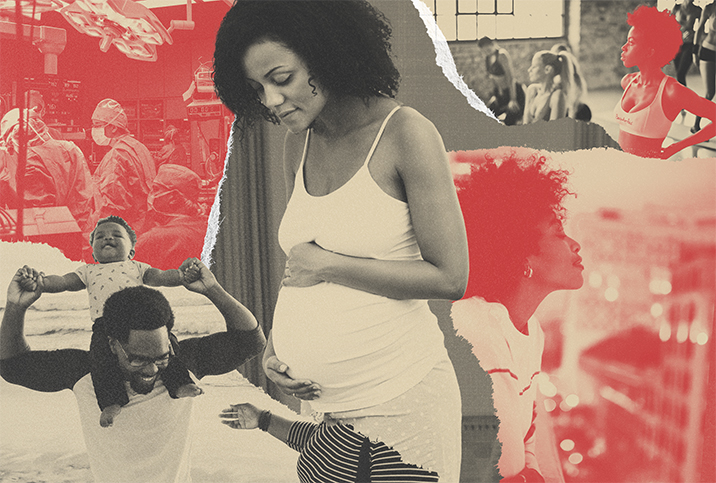The Ins and Outs of Water Birth

Let's not beat around the bush—giving birth is one of the most difficult tasks a person can do. No matter what drugs, breathing techniques or meditation exercises you try, it's always going to be an ordeal. Nevertheless, certain birthing methods can help to make the process just a little easier.
One of the trendiest of those methods is water birth, whose followers include the likes of Thandie Newton, Charlotte Church, Pamela Anderson and Jennifer Connelly. As of 2018, 10 percent of women in the U.K. reportedly gave birth into water, while 20 percent used water or a birthing pool during labor. While such statistics aren't known in the U.S., the New York Times has reported that it is just as trendy on this side of the pond.
What is a water birth?
A water birth, pretty straightforwardly, takes place in a pool of water. Most people use a birthing pool that is around 24 inches deep with 18 inches of water, but, as Ravina Bhanot, M.D., with Zonas Fertility, explained, any tub that can be filled to 18 inches can work. These can be purchased online, although a few hospitals will provide them. Theoretically, the buoyancy of the water helps to relieve the pain and discomfort of labor. Some women give birth while still submerged in the tub, while others prefer to get out of the pool during labor.
While the idea of giving birth in a pool of water may sound a little bizarre, it's widely accepted to be a safe practice. Bhanot said water births present "no extra risk to mother or baby."
And, as a 2014 review in The Journal of Perinatal Education explained, babies can be submerged in water for a short time after they are born, as they are still connected to the mother through the umbilical cord. In other words, there is little risk that a newborn could drown or get water in their lungs, as long as a professional is assisting in the water birth.
A 2019 study published in AOGS also found "no detrimental effects" of water submersion during labor.
As we know, labor can be an extremely painful and uncomfortable experience. The consistency, warmth and buoyancy of water can help to reduce pain and promote relaxation for the mother, particularly in the early phases of labor. As Lesley Gilchrist, a midwife and founder of My Expert Midwife, explained, "There is a strong evidence base which shows that laboring in water can help to reduce pain and shorten the duration of labor."
Several studies have shown that women often experience pain relief while going through labor in a pool of water. A 2020 study in New Zealand noted "a reduction in the use of pain relief in the form of inhalation/Entonox, epidural, and opioid in the group of women who used water immersion for labour and birth."
Gilchrist added, "Water has several important benefits—for example, helping the mother feel more relaxed and focused, and reducing the likelihood of tearing during the birth." In fact, as the 2014 review noted, water births tend to increase relaxation in the mother, and as the study put it, "a calm, relaxed mother is more likely to experience a calm, relaxed baby after birth."
What's a water birth really like in practice?
Catherine Ball, a parenting journalist and mother of four, had a water birth with her third pregnancy. Overall, Ball's water birth went well. "My labor with my third was a bit stop-start and I didn't make much progress at first, so they didn't want me going into the pool too early as apparently it can slow labor down," she said. If someone has early contractions, a water birth can slow down labor, but if someone is in established labor, which is when a cervix has dilated to 4cm, water births can speed things up. One downside was that it took a while for the pool to fill up, so preparation is key.
"Once I got into the pool, though, the warm water really helped and I felt it really helped me get into the zone," she said. "Almost as soon as I was in the water, I felt ready to push and my daughter came out really quickly into the water—I didn't even realize she had been born at first, as I didn't get the intense stinging experience you usually get during crowning.
"The actual pushing stage and giving birth felt so much easier due to being in the water. I just wish I had got in there sooner, as I didn't really get long in the water," Ball continued. Apparently, her daughter, now 7, still loves to swim. "She always says this is because she was born in the water!"
Birthing preparation
If you're planning on giving birth in a tub or a birthing pool, you'll need to make sure you're well-prepared and your birthing pool is safe. You should always have the assistance of a professional to make sure you've set things up properly.
Bhanot said to use regular, clean water that isn't hotter than 37.5 degrees Celsius. Any tub can be used, but the water should be deep enough to cover the stomach. Ideally, you'll have a midwife or doctor present, along with a partner for support, whether that's your partner or another loved one.
Pros and cons of water birth
Pros
- You will be less likely to require pain medication.
- Water births are generally safe for mother and baby.
- Can be more comfortable for the mother.
- Can help to mobilize the baby and speed up labor when it’s time to give birth.
Cons
- Makes monitoring the labor, baby and contractions more difficult.
- You may need to buy your own birthing pool and have a home birth.
- Not always suitable for first-time mothers.
While water birth is considered a safe birth plan, everyone's experience and preferences are unique. Consulting a doctor in preparation is essential. And remember: Giving birth looks different for everyone, whether that's above or below water.


















